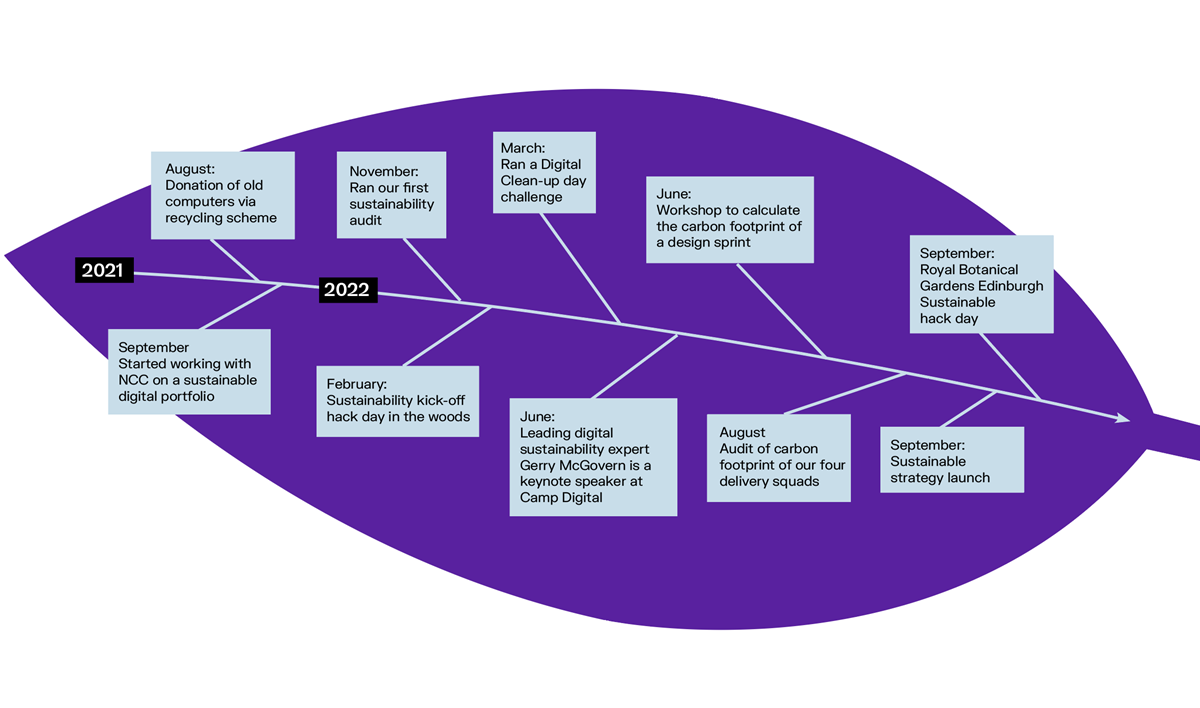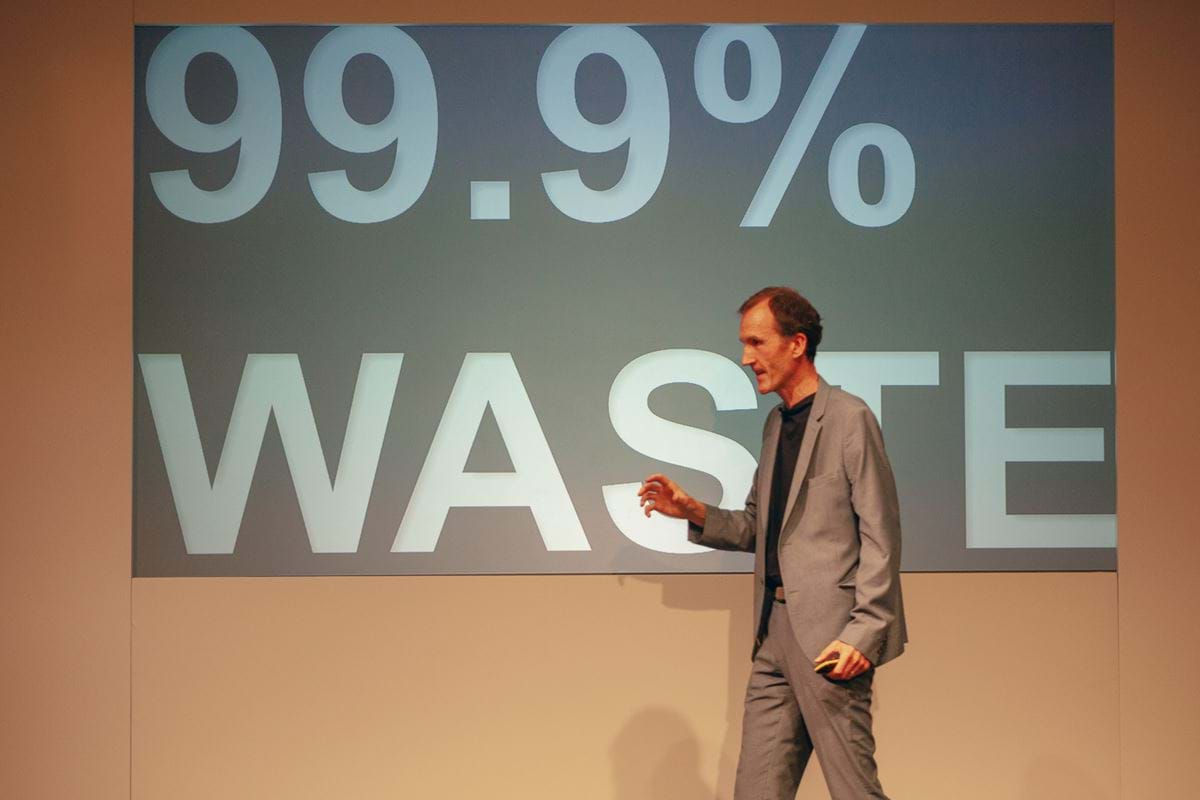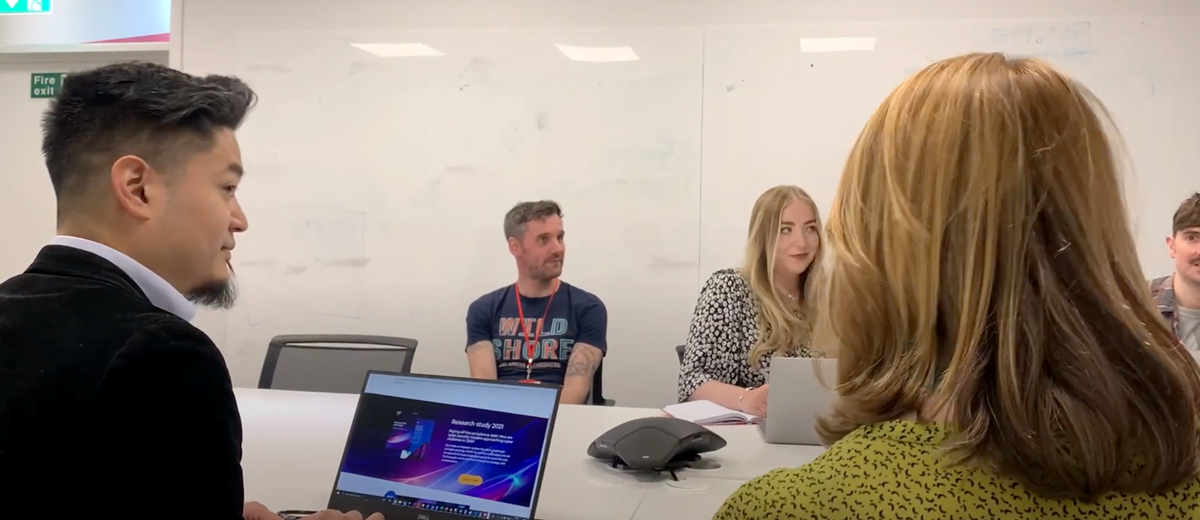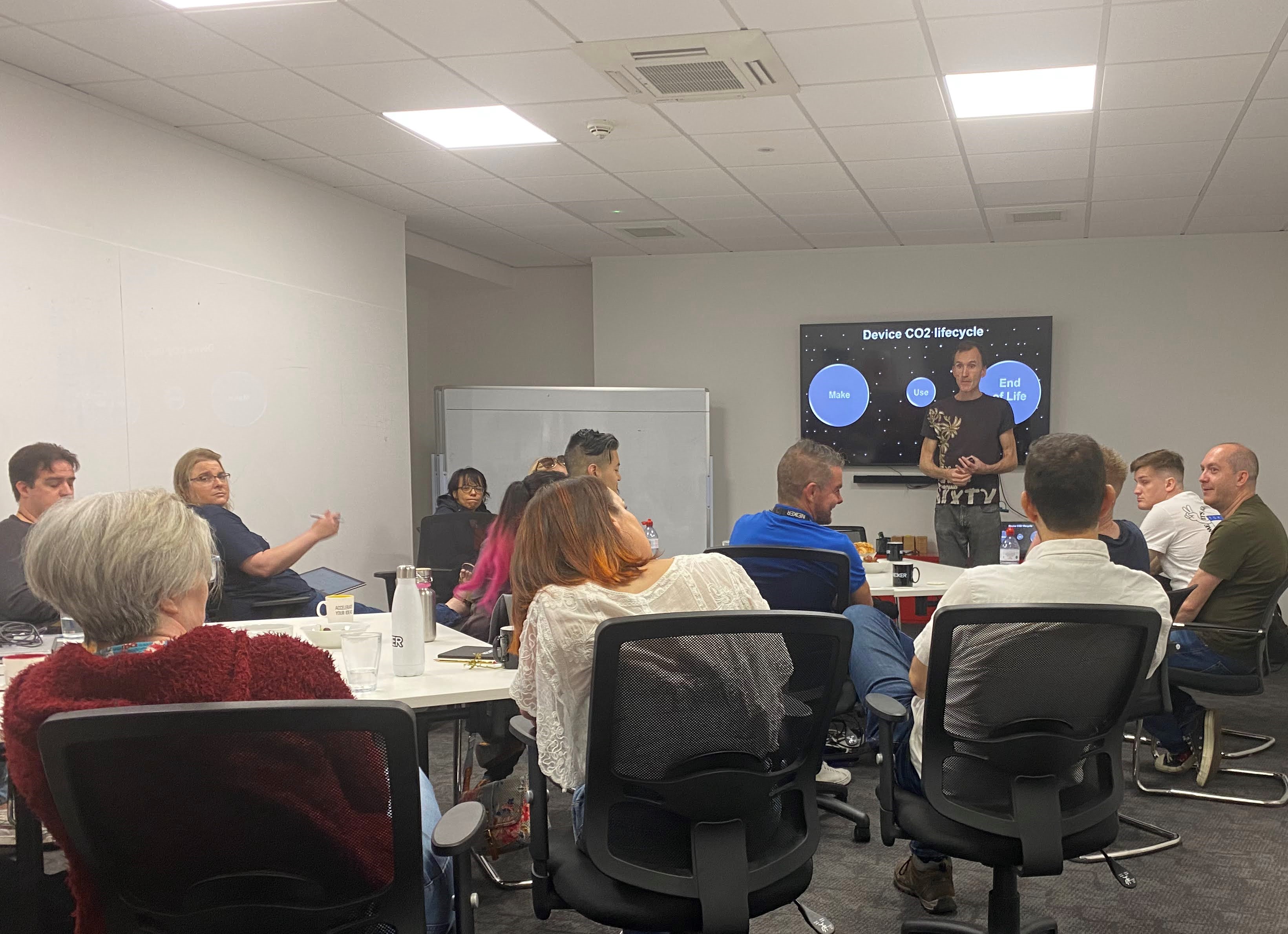Our sustainability strategy
5 minute read
We're proud to launch our sustainability strategy. It's been a long time coming, and now we're committing to some big things, on a personal, business unit and group level.
Why are we doing this?
Throughout the past year we’ve been exploring the environmental impact of digital creation and consumption. It’s complex, important and interesting and as a digital agency, we’ve become increasingly aware of our responsibility to understand how we can create longer-lasting, more sustainable digital products and services. This requires us to assess what harm we might be doing as much as measure how we might be helping people. To put the figures into perspective, the carbon impact of digital is equivalent to the carbon output of the entire airline industry (Gerry McGovern, World Wide Waste). Action is required for the planet, and we want to do our part.

We’ve invested in a hack day in the woods to kick off our business plan this year. There we worked on goals and ideas for both our internal consumption and emissions as well as how we can help clients with theirs. This is part of ongoing work across the whole of the Nexer Group, so we can join forces and maximise the social and commercial impact. During the summer we welcomed leading digital sustainability expert Gerry McGovern as a keynote speaker at Camp Digital 2022. Gerry also led a workshop at our Macclesfield office, where he walked us through a methodology to calculate the carbon footprint of a design sprint from inception to completion. We marked Digital Cleanup day with a campaign to track how much email storage we use, and how much we can save by deleting and archiving unwanted items. It’s important we set and track small goals to shift every day behaviours, as well as tackle larger scale objectives as a group.

We describe ourselves as a Human-centred design agency. That means we focus on bringing humanity to design and tech and keep people at the heart of everything we do. But what happens when that comes at a cost to the environment? The work we do can be more sustainable and environmentally friendly. We’re on a mission to become an equally Earth-centred design agency and deliver impactful work that benefits both people and the planet. There will be some clashes and contradictions along the way.
We want to be more conscious, continue learning and be open about where we can improve. So, we’re launching our sustainability strategy, to hold ourselves accountable, commit to creating sustainable products and services with our clients and change the way we operate internally. Our strategy is supported by the wider Nexer Group, which is aligned to the United Nations Compact Sustainability Initiative. Nexer Group has committed to reducing emissions by 50 per cent by 2030. The work we‘re doing to model carbon intensity, both for ourselves and our clients will play an important role in reviewing and evolving practices at group level.
This is a big undertaking, we’re under no illusion that our commitment will be straightforward, we’ll be constantly learning and iterating. It’s important to us that our journey is open to input and feedback from our team, clients, other organisations and experts in the field. To create these opportunities, we’ll work in the open as much as possible, and encourage collaboration wherever we can.
Many of our clients have Environmental, Social and Governance (ESG) commitments, but when we reviewed them, digital didn’t play a part. Similarly, GOV.UK has a collection of resources surrounding climate change for local authorities. However, none of these resources focus specifically on the impact of digital products and services. We see this as an opportunity, to show our clients the power of sustainable digital products and services.
Areas of strategic focus
Development, QA and Hosting
- Data centres require a large and constant supply of electricity to operate and keep the servers cool. So much so that some nations are seeing the advent of new policies and guidelines governing the location of centres, to avoid overloading the power grid. We will only use sustainable cloud infrastructures, such as Microsoft Azure, so that we’re hosting using green energy. MS Azure has made a commitment to running all data centres with renewable energy by 2025 and replenishing more water than they consume by 2030.
- Architecting and consolidating our client’s digital estates to promote re-use. Reducing the need for intensive app services, whilst maintaining and in places increasing their performance.
- Encouraging our clients to update older, deprecating systems to newer versions that are less intensive. For example, upgrading older Umbraco web estates to Umbraco 9 and 10 which runs off of .NET core. .NET core is at least 2x faster than the previous version, meaning we can likely downscale resources in Azure to half the size and see the same performance.
- Building products and services for longevity, so they don’t just work on newer devices. Planned obsolescence is a major contributor to carbon-intensive wasteful practices around the manufacture of technologies. It’s estimated that globally only around 5 per cent of electronics are recycled, and of that 5 per cent, we only recover between 30 and 40 per cent of the materials used to manufacture. By designing and building products which work on older devices we enhance the longevity of devices. We can reduce the amount of waste and carbon generated through manufacturing and extracting resources. By designing for older devices, we can ensure the benefits of the products we create can be enjoyed by more people, for longer.
- Exploring technologies that promote headless content, such as Contentful, Umbraco and Optimizely DXP, so we can build syndicated re-usable content structures.
- Performing sustainability audits as standard within our onboarding process and on current client estates. We use a range of tools including the Carbon Calculator and Microsoft’s Emissions Impact Dashboard, so we can begin to benchmark, monitor and improve.
Design
- Developing sustainable design principles that are centred around designing for longevity. These principles will underpin the way that we research, design services, content, digital products. We’ll look to create an open source toolkit that put these principles into practice for specific design disciplines.
- Our principles for interface design will highlight the design elements that have an effect on the site or application’s carbon footprint so that we actively avoid these from the outset. Examples would be avoiding auto-playing videos and heavy imagery and considering which fonts need to be loaded.
- We will weigh our priorities of visual impact, accessibility, user experience and sustainable design to ensure we continue to design effective products and services that are also planet conscious.
- Good user experience, something that we already strive for, is also critical for minimising unnecessary activity online by getting users to their objectives quickly and easily.
- Content designed for re-use, and making content structures flatter, easier to maintain and reducing waste and duplication. Information architecture, content formats and editorial governance play a part in this
- Our ultimate aim for our Service Design practice is for it to have its own set of principles, designed to ensure we balance user needs with climate impact across the end-to-end journey. These may include guidance around the impact of using different channels (digital variants, post, phone etc) to deliver information to the end user as well as considering the impact of different technologies we use to deliver a service. Due to the complexity of accurately calculating the potential impact of channels and technologies in different circumstances, we see this as a more long-term goal.
- There is also an opportunity in our design work to think about nudging user behaviour towards making more sustainable choices. Examples would be highlighting public transport over driving directions or offering low-carbon delivery options.
Working with clients to be more sustainable

NCC Group
Our longstanding relationship with NCC Group, a global cyber security and risk mitigation expert, began back in 2015. Over the years we have developed a large, global website estate and earlier this year NCC Group joined us on our sustainability mission.
For NCC Group, we defined digital sustainability as efficiency, enhancing the user experience, protecting against technical debt and future-proofing of processes in an growing, global business.
After taking some initial benchmarks, we explored ways in which we can alter the estate to be more sustainable. These included consolidating code, upgrading intensive Umbraco websites, decommissioning websites, empowering content editors to make better choices when it comes to media and content and reviewing content structures between global websites.
NCC Group has it's own Environmental, Social and Governance commitments, and was keen to explore how digital contributes to them. NCC Group is promoting organisational behaviour change, by empowering its team to think eco-design when it comes to digital.
Royal Botanic Garden Edinburgh
RBGE focus on accelerating species discovery and proving a knowledge resource. They also identify species at imminent risk of extinction, those of particular importance to humankind and diversity in poorly known and threatened areas of the world.
RBGE have an environmental policy and carbon footprint report, but digital impact was not being considered. There was an opportunity to expand our knowledge of the ecological impact of digital, to transform their main website into a cleaner, greener space.
During our onboarding project, we ran our first sustainability audit. Using both manual and automated auditing tools, a carbon footprint value was given to key pages, including the homepage. The output of this was a prioritised activity list.
Following the implementation of the changes, the homepage showed a C02 reduction from 1.70g to 0.97g for each home page visit, saving of 53%. This equated to a saving of circa 22KG of CO2 per month.
We’re also holding a September meet-up with RBGE to discuss our progress so far, and what we might do in the future to progress the work.

Department for Education
Department for Education identified digital sustainability as a key area of interest for their teams. DfE supported our workshop with Gerry McGovern by submitting some data around an end-to-end project that Nexer have been involved with. This included the carbon weight of the end product, and the carbon required to use the service.
This model gave an indication of the overall carbon intensity of the project and prompted some productive conversations around policies like device renewal and measuring progress.
Wild Rumpus
Wild Rumpus are a social enterprise that produces large-scale outdoor arts and culture events in natural landscapes. The organisation believes that arts and culture have a unique role to play in helping people gain new perspectives on the existential threat posed to civilisation by the loss of biodiversity.
We’re working with Wild Rumpus to ensure that their web estate and digital footprint align with their sustainable ethos and principles. We're forming a series of accessibility and sustainability recommendations for their new website, which can be implemented to attract international audiences.
Considering our ways of working
Gerry McGovern worked with us to create a model which we can use to examine the impact of our client projects, with different delivery models. We began by looking at data from a Department for Education project, that our team members were embedded within. We looked at a variety of data sets including devices used, for the project duration, digital tools used, meetings and workshops, analytics and tracking, and calculating the overall weight of webpages themselves including forms and downloads.
Calculating our team and delivery squads' carbon output
Our approach to calculating carbon intensity is informed by our workshop with Gerry McGovern. We’ve calculated the carbon usage of each of our four squads. As a starting point, we began tracking the devices that the team use such as laptops and second monitors. Stage two of this process will involve taking a closer look at software and digital tools used including email providers, collaboration tools like Miro, MURAL, and Figma and other applications. We will also factor in data storage, including internal Microsoft Teams channels and servers. We’re also reviewing our internal ways of working and identifying opportunities for improvement. That includes both digital practices and how we work in the office, homeworking, hybrid and travelling when we need to.
Carbon Impact of a digital product or service in proposals
By using the same model we’ve used to calculate out own consumption, we’ll give clients an overall picture of the carbon impact of their digital project and include a calculation in proposals. We’ll look at the squad calculation and combine it with the estimated project time to work out a creation calculation, and then estimate ongoing usage and maintenance. Passing on this information to our clients will play a part in longer-term road mapping, and will educate and inform conscious sustainable decisions.
In summary
This is just a start but it feels like meaningful progress, and useful to share. We look forward to sharing further activities and knowledge with our wider group, our peers and our clients, and learning from other along the way. If you'd like to get in touch about our work, contribute or discuss any support, we'd love to help you.
Get in touch
If you would like to work with our team on your project, email us at hello@nexerdigital.com or call our Macclesfield office on +44 (0)1625 725446

